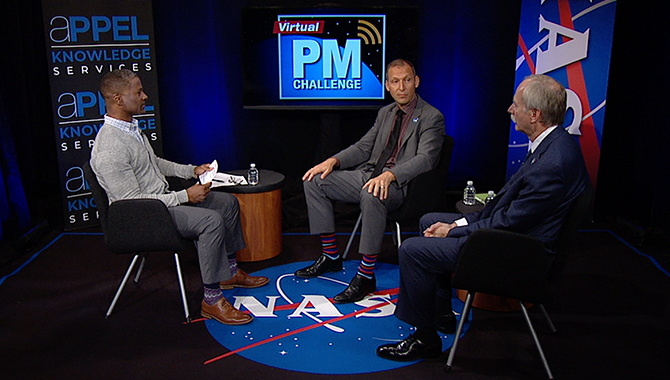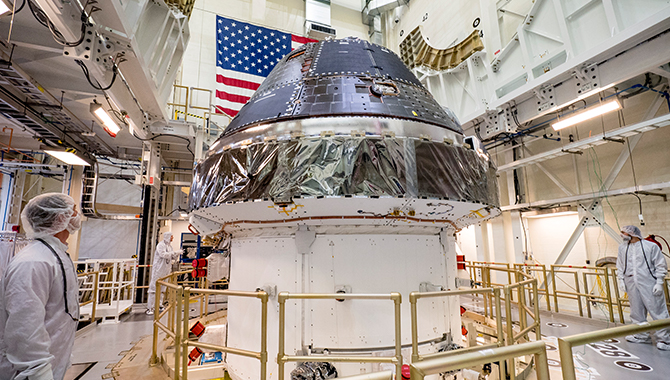
The Orion Crew Module Uprighting System inflates large balloons to flip the module over if it lands upside down.
Credit: NASA
Crucial, complex safety system will rocket astronauts to safety at the first sign of danger.
NASA’s Orion spacecraft and the Space Launch System rocket are the future of U.S. space exploration, designed to return astronauts to the surface of the Moon, enable them to build an orbiting lunar outpost, and eventually travel to Mars.
Successfully meeting goals as ambitious as these requires a great deal of testing. And this spring, the Orion team is moving forward with a series of critical component tests while preparing for a major test of the crucial Launch Abort System (LAS), known as Ascent Abort Test-2, planned for June. The LAS is a rocket-powered tower that sits atop and cocoons the 22,000-pound Orion crew module. During the test, a series of rockets will fire, pulling the crew module away from the launch vehicle and guiding it to safety.
The test will subject the LAS to the full stresses of an emergency separation of the Orion crew module from a rocket beneath it during a simulated launch emergency. The test will take place at an altitude about 31,000 ft, with the rocket traveling more than 1,000 miles per hour. The crew module will gain more than two miles of altitude in just 15 seconds as it pulls away from the rocket. The full test will take less than three minutes and is timed to the millisecond.
The data NASA gathers from the jettisoned flight recorders following the test will validate the performance of the complex LAS system in activating instantly and guiding the Orion capsule to safety, away from a malfunctioning rocket. It is the only remaining scheduled test of the complete LAS system.
The Orion crew module to be used for the test is a simplified version that mimics a crewed capsule’s mass distribution and shape, but not its complement of equipment. It was fabricated at NASA’s Langley Research Center in Hampton, Virginia and has been painted with distinctive markings to better track it’s attitude and trajectory during the test.
The LAS weighs about 16,000 pounds, comprising a lightweight, composite fairing that surrounds the crew capsule during launch, an abort motor capable of producing 400,000 pounds of thrust, an attitude control motor that correctly positions the crew capsule for parachute deployment, and a jettison motor, that separates the LAS from the crew capsule once the astronauts are safely away from the launch rocket.
The upcoming test is not the first of the LAS. On May 6, 2010, NASA conducted the Pad Abort-1 flight test at the White Sands Missile Range outside Las Cruces, New Mexico. For that flight, however, the LAS/Orion crew capsule was not atop a rocket. Instead, the LAS abort motor lifted the spacecraft to 6,000 ft, then separated from the crew module, which parachuted to Earth. The LAS for that test was also equipped with prototype or modified components.
NASA has been testing individual components of the LAS independently for years since, building to the Ascent Abort Test-2 and to a crewed Orion mission in the years beyond. In December, NASA, Northrop Grumman, and Lockheed Martin successfully completed a cold-weather test of the abort motor in Promontory, Utah.
Meanwhile, engineers at a Northrop Grumman facility in Elkton, Maryland, are conducting a series of tests of what is likely the most complex component of the LAS—the Launch Abort System Attitude Control Motor. During a 30-second test on March 20, 2019, the motor produced 7,000 pounds of thrust. This motor, working through eight valves, steers the Orion crew module to safety and orients it with the heat shield facing the Earth.
Finally, also in March, engineers tested what is known as the Crew Module Uprighting System (CMUS) off the coast of North Carolina. The CMUS, which is not part of the LAS, helps astronauts right the capsule in the event it lands in the ocean upside down, with the hatch and windows below water.
The CMUS inflates a series of five orange balloons in less than four minutes. The added buoyancy flips the crew module over and the balloons serve as markers for rescue personnel searching for the capsule at sea. The test was a success, proving that CMUS will still right the capsule even if one of the balloons fails to inflate.
NASA will soon partner with the U.S. Coast Guard to test the CMUS in the stronger waves further off shore in the Atlantic Ocean, where future Orion missions are likely to land.









